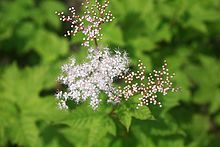| Filipendula glaberrima | |
|---|---|

| |
| Scientific classification | |
| Kingdom: | Plantae |
| Clade: | Tracheophytes |
| Clade: | Angiosperms |
| Clade: | Eudicots |
| Clade: | Rosids |
| Order: | Rosales |
| Family: | Rosaceae |
| Genus: | Filipendula |
| Species: | F. glaberrima |
| Binomial name | |
| Filipendula glaberrima Nakai 1902 | |
Filipendula glaberrima, also called Korean meadowsweet, is a species of plant in the family Rosaceae that is native to Korea. The genus Filipendula is classified as a perennial herbaceous ornamental plant of the botanical family Rosaceae. The historical utilization of Filipendula plants in traditional medicine can be attributed to their diuretic, antiseptic, anti-rheumatic, stomachic, and antacid qualities. Plants belonging to the genus Filipendula have various beneficial properties, including antioxidant capacity, anticancer activity, anti-inflammatory effects, anti-colitis properties, anti-hyperalgesic properties, antigenotoxic effects, hepatoprotective activities, and skin-moisturizing properties.
References
- ^ English Names for Korean Native Plants (PDF). Pocheon: Korea National Arboretum. 2015. p. 470. ISBN 978-89-97450-98-5. Archived from the original (PDF) on 25 May 2017. Retrieved 8 December 2016 – via Korea Forest Service.
- "Filipendula glaberrima in Tropicos".
- Mi, Xiao-Jie; Kim, Jin-Kyu; Lee, Sanghyun; Moon, Sung-Kwon; Kim, Yeon-Ju; Kim, Hoon (2022-10-05). "In vitro assessment of the anti-inflammatory and skin-moisturizing effects of Filipendula palmata (Pall.) Maxim. On human keratinocytes and identification of its bioactive phytochemicals". Journal of Ethnopharmacology. 296: 115523. doi:10.1016/j.jep.2022.115523. ISSN 0378-8741.
- Samardžić, Stevan; Arsenijević, Jelena; Božić, Dragana; Milenković, Marina; Tešević, Vele; Maksimović, Zoran (2018-03-01). "Antioxidant, anti-inflammatory and gastroprotective activity of Filipendula ulmaria (L.) Maxim. and Filipendula vulgaris Moench". Journal of Ethnopharmacology. 213: 132–137. doi:10.1016/j.jep.2017.11.013. ISSN 0378-8741.
- ^ Bespalov, Vladimir G.; Alexandrov, Valerij A.; Semenov, Alexander L.; Vysochina, Galina I.; Kostikova, Vera A.; Baranenko, Denis A. (2018-12-05). "The inhibitory effect of Filipendula ulmaria (L.) Maxim. on colorectal carcinogenesis induced in rats by methylnitrosourea". Journal of Ethnopharmacology. 227: 1–7. doi:10.1016/j.jep.2018.08.013. ISSN 0378-8741.
- ^ Samardžić, Stevan; Tomić, Maja; Pecikoza, Uroš; Stepanović-Petrović, Radica; Maksimović, Zoran (2016-12-04). "Antihyperalgesic activity of Filipendula ulmaria (L.) Maxim. and Filipendula vulgaris Moench in a rat model of inflammation". Journal of Ethnopharmacology. 193: 652–656. doi:10.1016/j.jep.2016.10.024. ISSN 0378-8741.
- Jung, Jaemee; Hong, Mijin; Hwang, Dahyun (2023-07-01). "The water extract of Korean Filipendula glaberrima Nakai attenuates acute colitis by suppressing inflammation via the MAPK and NF-κB pathways". Journal of Functional Foods. 106: 105606. doi:10.1016/j.jff.2023.105606. ISSN 1756-4646.
- Pukalskienė, M.; Venskutonis, P. R.; Pukalskas, A. (2015-05-01). "Phytochemical composition and antioxidant properties of Filipendula vulgaris as a source of healthy functional ingredients". Journal of Functional Foods. 15: 233–242. doi:10.1016/j.jff.2015.03.002. ISSN 1756-4646.
- Kiyohara, H.; Matsumoto, T.; Yamada, H. (2002-01-01). "Intestinal immune system modulating polysaccharides in a Japanese herbal (Kampo) medicine, Juzen-Taiho-To". Phytomedicine. 9 (7): 614–624. doi:10.1078/094471102321616427. ISSN 0944-7113.
External links
- [REDACTED] Media related to Filipendula glaberrima at Wikimedia Commons
- [REDACTED] Data related to Filipendula glaberrima at Wikispecies
This Rosoideae article is a stub. You can help Misplaced Pages by expanding it. |